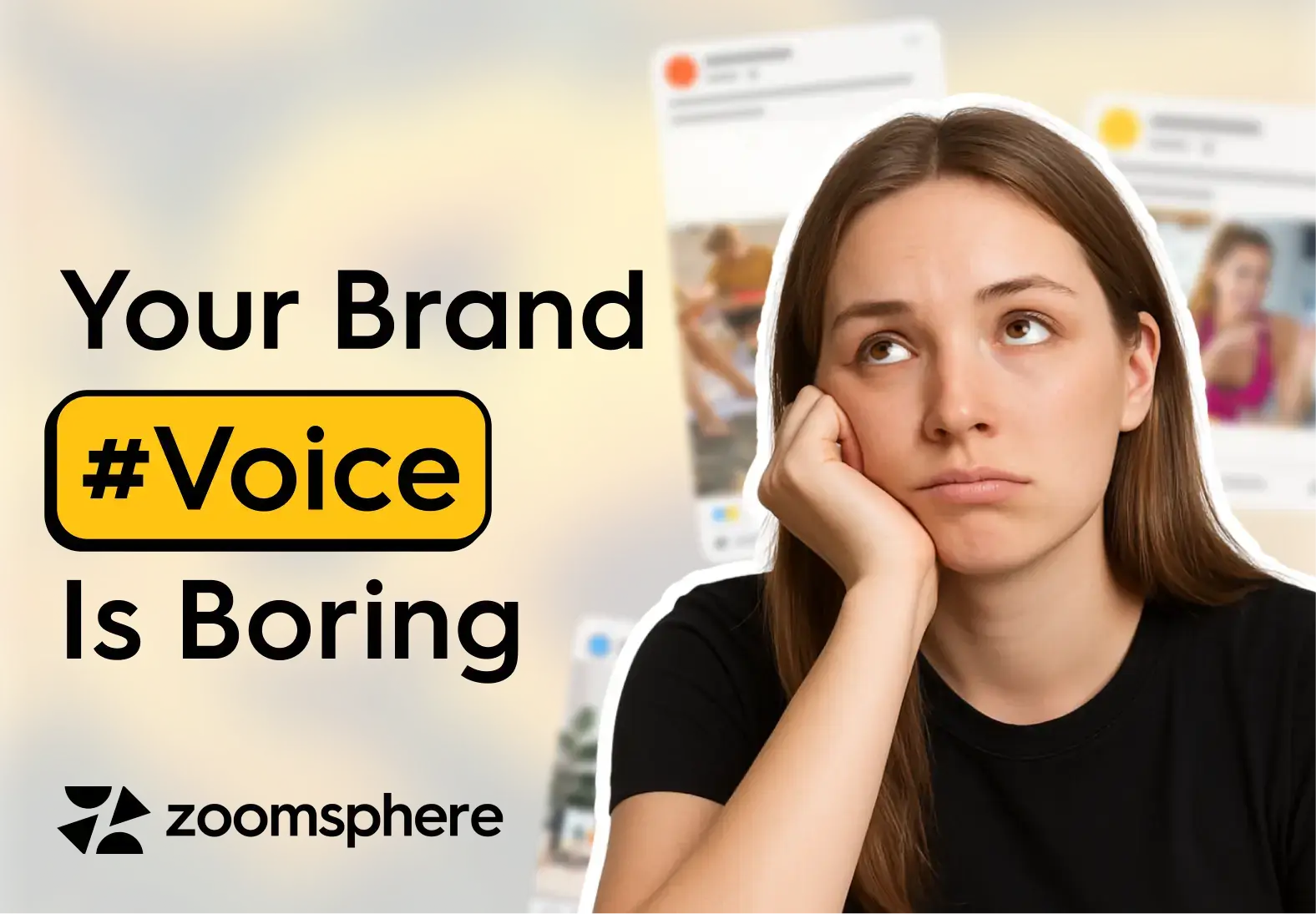How the Best Brands Speak—and Get Heard

Let’s be honest. Most conversations about brand voice are the marketing equivalent of chewing on cardboard.
You’ve sat through them. A 42-slide deck packed with polite adjectives, some lorem ipsum dressed as tone guidelines, and someone quoting Apple like it hasn’t been done to death since 2007. Then it ends. Everyone nods. And the brand still sounds like the HR team wrote the Instagram captions.
Look: your audience knows what your brand voice is before you do. And if it’s not one they can spot, mock, screenshot, or impersonate? You’re being filtered out.
The best brands don’t “build” their voice. They expose it. Strip it down to something raw enough to feel human, then hold it steady — across platforms, across posts, even across mood swings.
If that makes you a little uncomfortable… good. That means you’re listening. Now let’s talk about why no one else is.
Your Brand Voice Is Either a Signature—or Static
Brand voice isn’t something you draft into a folder where nobody looks. It’s the unmistakable cadence, tone, choice of words—you know, the signature that sticks. Most brands claim to define brand voice in a PDF nobody reads. But if your messaging evaporates when you switch platforms, you only have corporate wallpaper… and not a voice.
What separates a signature from static?
A signature reads the same at 3 a.m. in Slack, in a cold email, and on your product page—without a logo or team intro. Static, by contrast, is forgettable. A hallucination. You move platforms, the audience forgets you existed.
Cases that actually walk the walk
Look at Duolingo—its owl isn’t just a mascot, it owns the tone across app, email, even the occasional meme. Marketing folks say Duolingo has one of the best modern brand voices in digital marketing.
Oatly’s irreverent, honest-to-you packaging and copy break nearly every copywriting rule—and it works. Their rebellious tone carries through in every phrase—even on their carton.
Trust is the filter
81% of consumers won’t even consider buying unless they trust your brand. No clarity, no trust—and your tone is your first trust checkpoint. If it’s inconsistent, canned, or “safe,” you’re disqualifying your brand before they click.
Brands that can’t explain their voice in one sentence don’t actually have one. They have formatting preference. If you can’t name your tone, you haven’t defined brand identity voice—you just assigned someone a thesaurus and called it a day.

The voice audit your tone docs never survived
If your brand voice guide sits in a folder, unused—start auditing. Is your tone consistent in Slack messages, press releases, and help articles? Does it feel like one voice, or five teams trying to out-serious each other? That drift is invisible—and deadly.
A signature brand voice holds—not just at launch, but over time, platform shifts, team changes. It doesn’t fade or bend. It’s eligibility, not decoration.
Speak Human or Get Ghosted
You could launch a new product with a corporate slide—bullet points, passive verbs, polished blandness—and nobody flinches. Because nobody cares.
Now, imagine launching it with the actual humans behind the brand: a crackle of urgency, maybe a cheeky aside, a jab at what your category does badly. That energy stops thumbs. That’s brand tone of voice in action.
Corporate Press Release vs Real Human Launch
Imagine this:
Brand A posts, “We are delighted to announce…”
Readers scroll past. Yawn.
Meanwhile, Brand B drops: “We couldn’t wait—we made something that actually saves your brain thirty minutes a day. Seriously. Because innovation means nothing if it doesn’t feel like relief.”
Now people lean in.
Emotional frequency lands
Several marketing studies prove: conversational tone raises retention by 18% and boosts trust by 22%. That’s real impact. Humans mirror what they read. If your tone is flat, engagement dips too.
Brands like Duolingo, Wendy’s, and Liquid Death—they’re irreverent, unpredictable, sometimes a bit unhinged, but never ignored. Their brand personality and voice show up in every tweet, ad, or support reply—without sounding rehearsed.
You’re not ignored for being small
Quiet brands aren’t overlooked because they lack budget. They’re overlooked because they sound like someone who hates writing social captions. If your tone doesn’t feel human, people don’t engage. They exit.
Tone is the ticket people use to decide if you’re worth paying attention to. If it feels robotic, overly polished, or safe, that’s your signal people are already disengaged—even before they let your message sink in.
Speak like a person. Not like a brand. Keep the emotional frequency high. Because in 2025, silence means irrelevance.
Your Voice Shouldn’t Depend on Who Logged In Today
Every brand claims to have a voice—but too often it's whoever typed the Slack message that morning. That inconsistency can cost you. According to research, inconsistent brand voice can cost companies up to 23% in revenue. If your tone jumps from meme-friendly to IRS-formal across platforms, you’re bleeding credibility—and sentiment.
{{form-component}}
When Meme Monday and Newsletter Wednesday Sound Like Different Brands
Imagine the social team cracks a witty meme, but your newsletter reads like legal documentation. Then your ads go corporate-cold. That’s not versatility—that’s tone bootstrap collapse. It’s subtle audience whiplash. People feel it. Their minds bounce.
The brain actually prefers patterns—consistent rhythm = smoother processing. A mismatched tone becomes friction. It triggers fatigue. And fatigue means people stop listening. Without consistency in brand messaging, your content becomes seasoning, not substance.
The Agile Guide You Actually Need
Forget forty-page manuals nobody uses. What you need is a Minimum Viable Voice doc—five critical lines:
- Words we use regularly
- Words we ban
- A pulsing example of nailed tone
- A cringe example companies actually wrote
- Who signs off with a pulse (not a committee)
That is the modern version of brand voice guidelines or a brand voice and tone guide—with actual teeth, not just corporate wallpaper.
Lock Tone at the Source
You can lock tone at content creation—not after it drifts through layers of edits. That means tone gets aligned before the first comment.
The brand voices derailed by “just a quick rewrite” can be criminally underreported. One errant sentence from a well-meaning exec? Tone distortion, trust erosion. With the right process, you keep that from happening.
You don’t need perfect consistency—you need consistent enough that people feel your voice, even when platforms shift or teams churn. That’s not boring. That’s reliable. That’s a brand people learn to recognize—even without a logo.
Just Because You’re Loud Doesn’t Mean Anyone’s Listening
You posted five times this week. Congrats. But did anyone actually hear you?
Posting frequency isn’t audience connection. Not even close. If your voice doesn’t hook attention in under three seconds, your message evaporates.
Loud Doesn’t Mean Heard
Humans scroll. They skim. They ignore the expected. If your tone is flat and your message predictable, the brain simply skips it. It doesn’t process. That’s predictability fatigue, and it’s real.
Meanwhile, consumers refuse to buy from brands they don’t trust. Tone becomes a trust filter. If your brand messaging framework doesn’t account for emotional frequency, you’re broadcasting white noise.
Neal Schaffer, Digital & Social Media Marketing Consultant, nails it:
%20(1).webp)
That’s the only way to break scrolling habits—don't just be loud, be noticeably unlike anything else.
Neal warns against copying other brands: translate what genuinely attracts your customers. That is the essence of tone of voice in marketing—and what earns screenshots.
Data, Don’t Guess
Analytics prove the point: emotion-matched captions outperform bland posts nearly every time. But you can’t optimize what you don’t measure. ZoomSphere's post performance statistics show you what works – and what doesn’t – in just two clicks.
{{cta-component}}
Revamp Your Brand Messaging Framework
If your messages bounce, it’s not because your idea flopped. It’s because your tone flopped.
Your brand voice and tone guide should include:
- The hooks that consistently pull engagement.
- The tonality that earns trust.
- A/B tested messaging that signals emotionally.
Loop that into your brand messaging framework and stop treating tone like decoration. It’s your first impression, your mirror test, your trust handshake.
If people aren’t listening, maybe it’s not you—they’re busy. But if your tone is replaceable, you are replaceable. Volume doesn’t equal attention. Subtlety, pattern breaks, emotional resonance—they do.
Engage tone deliberately. Measure it. Keep it unmistakable. Then watch how often your message actually registers.
Mediocre Voice = Mid Results. Pick a Side.
If your brand sounds safe, it’s safe to assume it won’t be remembered.
Holding on to a bland voice is a strategical choice. You’re choosing invisibility over impact. Medium-safe tone produces medium results—often zero traction. And zero traction isn’t a good strategy.
Irrelevance Is a Brand Disease
Brands like RyanAir, Oatly, and Mailchimp all court controversy—or at least eccentricity. RyanAir’s borderline rogue messaging has made PR folks squirm—but it also makes people notice. Oatly’s irreverence defies dairy norms. Mailchimp is refreshingly odd in a sea of corporate sludge. They may not play nice, but they don’t fade.
You don’t need to be unhinged. You just need to be impossible to ignore.
Emotion Risks Remembered Reactions
Neuroscience proves that brains remember emotional triggers—with pain or discomfort, often more than joy. That’s why unforgettable brands don’t dress nicely; they provoke. If your brand tone never tilts off-center, it’s never setting a tone in the first place.
If your audience can’t finish your sentence in their heads, it’s because they aren’t reading the start.
How to Establish Brand Voice That Isn’t Beige
True brand identity voice doesn’t come from safe adjectives. It emerges from contrast. What would happen if you chose the words that unsettle a little—or what your competitors avoid entirely? That shift—tasteful but bold—is what people screenshot. That’s your edge.
Your tone is a decision. It’s the difference between being background noise or being the brand people talk about at the bar—or on Slack threads—after your ad eighties off. If your audience can’t reproduce your phrasing mentally, you’re not even in the game.
Choosing safe tone is choosing irrelevance. Choosing distinct tone is choosing visibility. Audiences won’t forgive passivity. Brands don’t get famous for being polite.
%20(1).webp)
GPT Can Mimic Tone. But Only Humans Can Mean It.
Sure, you can pump out AI-generated captions faster than you can drink your third espresso—and they might even score likes. But if your AI posts land better than your human ones, then you don’t have a voice. You have format.
Tone isn’t just style. It’s the emotional fingerprint of your brand. And that’s something AI can imitate—but never own.
The Illusion of Authenticity
AI can clone sentence structure. It can echo brand identity voice. But it can’t carry your why. It can’t hold context. It misses what you really mean—the emotion, the intent. Result: content that feels hollow. Empty. And easily forgettable.
When consumers sniff canned sounding copy, they sense inauthenticity. That matters. According to Forbes, 86% of consumers say authenticity matters more than advertising, and 77% are willing to pay more for it.
Consistency Isn’t Enough—Context Is King
Repeated tone without emotional variation is still a flatline. A tone anyone can replicate in AI is already diluted. If your brand voice and tone guide reads like a fill-in-the-blanks pattern, someone else’s software could replicate it.
People recognize cadence. They feel rhythm. A brand voice that lacks nuance—or worse, feels autopilot—loses instantly.
When AI Outperforms Humans, Your Voice Is Missing
Look: if your AI-generated post outperforms the human one, your human side has failed. You’re not giving marketers, customers, or audiences anything they can’t already get from a generic bot.
To really mean something, you need a voice that only you can produce. That means identity, intent, quirks, contradictions, and even occasional missteps—because authenticity isn’t perfection. It’s truth.
AI is fast. But sincerity is slow—deliberate. Your tone must exist in the gray between risk and relatability.
Would You Screenshot Your Own Brand’s Caption If It Wasn’t Yours?
If your brand voice doesn’t stop your own thumb mid-scroll, it’s filler… not a voice.
You know what we’re talking about. That post that quietly fades into a crowd of other beige brands all “thrilled to announce” something nobody asked for. Would you share it? Would your social team? Would anyone? Probably not. And if that stings, that’s the point.
The best brand voice doesn’t just “align with values.” It bleeds into everything—bios, banners, Slack replies, out-of-office autoresponders. It gets screenshotted. Reposted. Occasionally roasted. But it’s alive. And alive gets heard.
So, before you post again, ask the question that matters:
Would I care about this if it didn’t have our logo on it?
If the answer’s no, your voice needs either a burial or a proper rebuild.
ZoomSphere won’t fake your voice—but it will help you plan it, align it, and measure if it’s working. So when you finally say something worth hearing, you won’t whisper it into a platform void.












Heading 1
Heading 2
Heading 3
Heading 4
Heading 5
Heading 6
Lorem ipsum dolor sit amet, consectetur adipiscing elit, sed do eiusmod tempor incididunt ut labore et dolore magna aliqua. Ut enim ad minim veniam, quis nostrud exercitation ullamco laboris nisi ut aliquip ex ea commodo consequat. Duis aute irure dolor in reprehenderit in voluptate velit esse cillum dolore eu fugiat nulla pariatur.
Block quote
Ordered list

- Item 1
- Item 2
- Item 3
Unordered list
- Item A
- Item B
- Item C
Bold text
Emphasis
Superscript
Subscript



.webp)


%20(1).webp)
%20(1).webp)
%20(1).webp)

